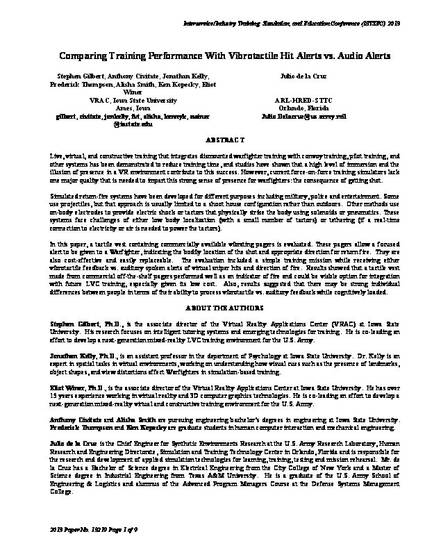
Live, virtual, and constructive training that integrates dismounted warfighter training with convoy training, pilot training, and other systems has been demonstrated to reduce training time, and studies have shown that a high level of immersion and the illusion of presence in a VR environment contribute to this success. However, current force-on-force training simulators lack one major quality that is needed to impart this strong sense of presence for warfighters: the consequence of getting shot.
Simulated return-fire systems have been developed for different purposes including military, police and entertainment. Some use projectiles, but that approach is usually limited to a shoot house configuration rather than outdoors. Other methods use on-body electrodes to provide electric shock or tactors that physically strike the body using solenoids or pneumatics. These systems face challenges of either low body localization (with a small number of tactors) or tethering (if a real-time connection to electricity or air is needed to power the tactors).
In this paper, a tactile vest containing commercially available vibrating pagers is evaluated. These pagers allow a focused alert to be given to a Warfighter, indicating the bodily location of the shot and appropriate direction for return fire. They are also cost-effective and easily replaceable. The evaluation included a simple training mission while receiving either vibrotactile feedback vs. auditory spoken alerts of virtual sniper hits and direction of fire. Results showed that a tactile vest made from commercial off-the-shelf pagers performed well as an indicator of fire and could be viable option for integration with future LVC training, especially given its low cost. Also, results suggested that there may be strong individual differences between people in terms of their ability to process vibrotactile vs. auditory feedback while cognitively loaded.
Available at: http://works.bepress.com/jonathan_kelly/20/

This proceeding is published as Gilbert, S., Civitate, A., Thompson, F., Smith, A., Kopecky, K., Winer, E., de la Cruz, J. (2013) "Comparing Training Performance With Vibrotactile Hit Alerts vs. Audio Alerts," Paper No. 13219. The Interservice/Industry Training, Simulation & Education Conference (I/ITSEC), Orlando, FL, December 2-5, 2013.